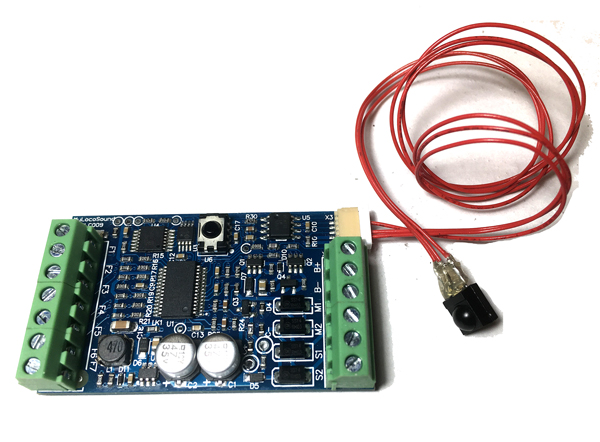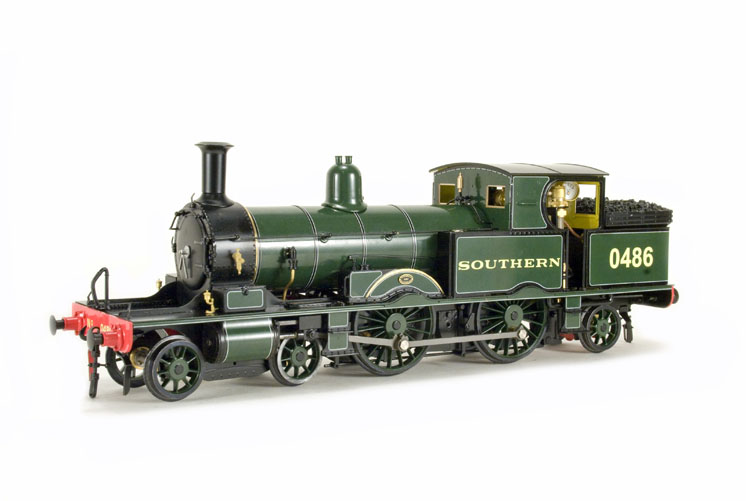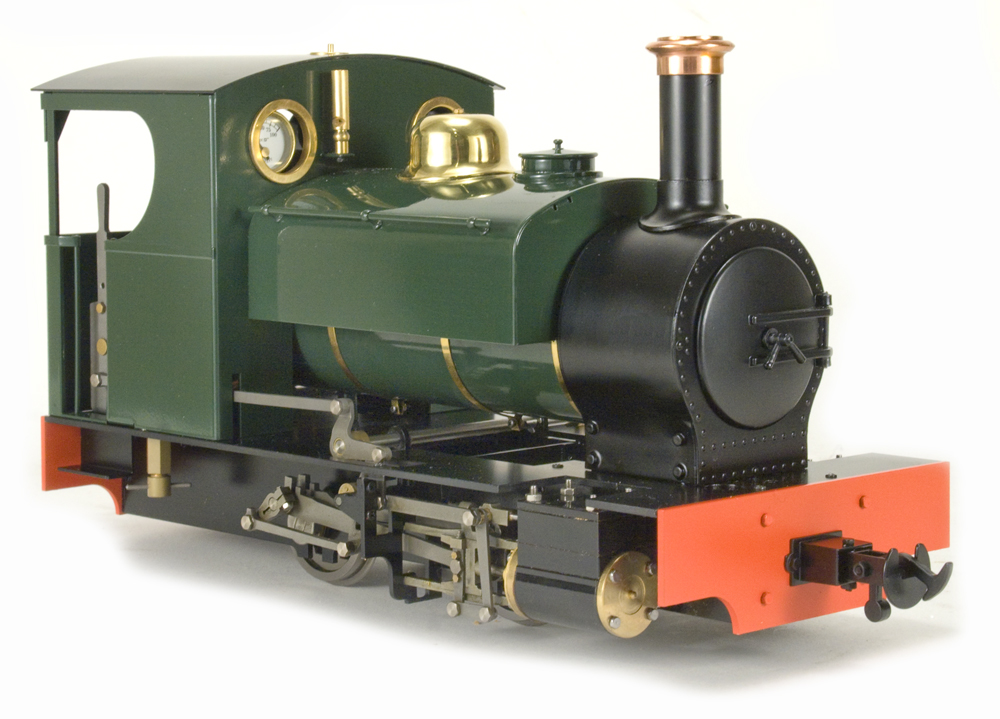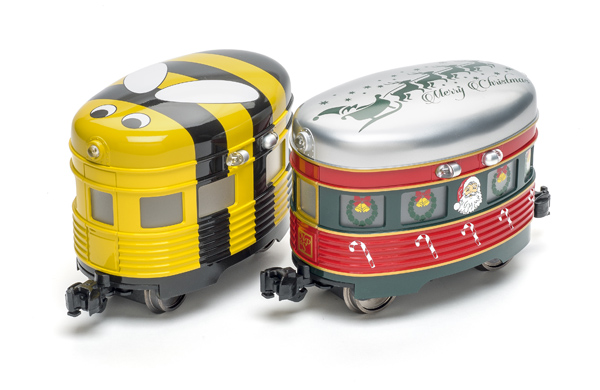Available in the US from:
G Scale Graphics
4118 Clayton Ct.
Ft. Collins CO 80525
Price: $79
Website: www.mylocosound.com
MyLocoSound “Blue” sound system; economical system; provides a variety of typical steam-engine sounds; can be run with track power or battery R/C; not DCC compatible. Dimensions: 2 1/4″ x 1 3/8″ x 1/2″
Pros: Easy installation; lots of sound-adjustment flexibility via handheld remote (sold separately); well-written instructions for installing and programming the board
Cons: Some sounds cannot play at the same time; some whistle sounds start abruptly
This latest generation is called MyLocoSound Blue, “blue” referring to the color of the PC board as a means of differentiating it from older versions. It’s a standalone sound system that can be used in traditional track-powered operating environments or controlled by a third-party R/C control system. It is not DCC-compatible. There are few standalone sound systems being manufactured these days, so this is a welcome part of that line-up. It is intended to be a budget-friendly alternative to high end, fully digital sound systems, and it fills that role nicely.
At 21/4″ x 13/8″ x 1/2″, the board is average in size for a sound system. It has two rows of screw terminals, one on either end, plus a socket for an external IR (infrared) sensor to allow you to control or program the board without having to disassemble the locomotive to get to the board itself.
I installed this board in a Bachmann 2-6-0, as that gave me a chance to try it in its bread-and-butter environment—traditional track-powered DC operation. MyLocoSound provides instructions online, which include easy-to-follow wiring directions for a variety of installations, including how to wire this to the “dummy board” that comes standard in this (and many other) Bachmann locomotives. Installation took me all of 10 minutes, including waiting for the soldering iron to heat up. Note that my installation did not include running magnetic sensors to the tender trucks to trigger bell and whistle sounds via track magnets, as is common in that environment. The board is designed to accept such inputs; it would just be a matter of installing the sensors and hooking them up to the appropriate screw terminals.
When operating in a track-powered environment, you will need to add an external battery to power the board when the track voltage is low. MyLocoSound offers a 9V rechargeable battery (sold separately) for this. The board shuts itself down after a minute of no power, so that will help to keep the battery charged between runs.
Perhaps the biggest upgrade to this board is the addition of more memory, so the steam version now includes programming and sounds for US, British, and Australasian locomotives. The biggest difference between these lies in the sounds and their behaviors. For example, there is no bell in the British operating environment. Instead, you get a short “toot” of the whistle when the bell function is triggered. In addition to having your choice of all sounds and environments, there are expanded ways to control the sounds. You can choose between manual and automatic control for various sounds, and you can control how often various sounds play. You can also control the pitch of the whistle you select and the volume level of each individual sound.
Programming the board is done via a television remote. You can use a universal remote (code set to 0140), a Sony TV remote if you have one, or you can purchase one along with the sound card. The online manual offers refreshingly clear instructions on how to program these boards. I found them easy to follow and got my locomotive set up in short order. Changing sounds just to play around with things was simple as well.
But how does it sound? It’s important to remember that this is a budget-friendly sound board, with mostly analog-synthesized sounds. It sounds different than a high-end digital sound system and expecting similar quality is unrealistic. That said, I grew up working with my Dad, designing our own analog sound systems, so I have a pretty good feel for what is possible within those confines, and this board does a credible job. The chuff, air pump, and safety-valve sounds are all distinct and easily identifiable. The chuff varies in volume in response to throttle changes. If you speed up, it gets louder; if you slow, the chuff quiets down. The chuff can be triggered by an external switch or by the voltage going to the motor. You can calibrate this to get close to the prototypical number of chuffs per revolution (usually four), but it won’t be 100% spot on, as the locomotive can slow due to drag or load as it runs.
Like the chuffs, the whistles are analog syntheses. There are six preset whistles within each country setting, though the “Thomas” setting exists within all three, providing a total of 16 more-or-less distinct whistles. Their quality varies from whistle to whistle, with the British single-chime being my favorite. I was hoping for a single-chime option within the North American grouping, but they are all multi-chime. Some of the whistles start abruptly, with no volume build-up to full volume, almost like flipping a switch for the sound to turn on instead. To my ears, that detracted from the realism a bit. You can vary the pitch of each whistle while it’s playing, via the remote, which gives you a lot of flexibility in tailoring your whistle to each locomotive.
The bell is the same as that on the older-generation board. It is an air-rung bell, so it rings at a constant rate. There’s also a conductor calling “all aboard” or a guard’s whistle (British), injectors, safety valves, and brake squeal. All of the individual sounds’ volume levels can be controlled via the TV remote, even while the train is running around the railroad, so if you’re in a traditional track-powered environment and don’t want to install track magnets, you can use the remote. It is, however, infrared, which may not work in bright sunlight.
It’s worth noting that you cannot ring the bell and blow the whistle at the same time. When you blow the whistle, the bell will cut out while the whistle is blowing. The whistle takes priority over all other triggered sounds, except the chuff, which plays no matter what.
The MyLocoSound board is also offered with diesel and electric sound files. I hope to review these later. MyLocoSound has videos on their website of their steam and diesel boards so you can preview what you’re getting. They are, to my ears, representative of what you would hear in person.
like this system for what it is—reasonable sound at a reasonable price. This is not a very crowded field at the moment, so I’m pleased to see MyLocoSound continuing to up their game on their own. The hobby needs reasonably-priced sound systems like this, which are able to deliver flexibility and features similar to higher-priced systems.














